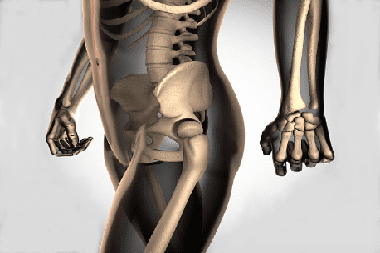Musculoskeletal system >>>> Diagnosis and treatment of osteoporosis
Diagnosis and treatment of osteoporosis.

For osteoporosis is characterized by the absence of an early clinical picture, so the diagnosis of osteoporosis are based on the following facts:
- Presence of previous bone fractures
- The age and gender of the patient (from 45 years old and mostly women),
- Heredity (are there any patients with osteoporosis in older generations),
- Sex hormone deficiency in men and women is associated with the possible development of osteoporosis,
- A history of diseases: celiac disease, diabetes mellitus, dysbiosis, chronic intestinal inflammation (colitis, Crohn disease), endocrine system diseases, kidney disease, rheumatic diseases and others.
Accurate X-ray diagnostics (X-ray morphometry) of skeletal diseases is essential. It makes it possible to determine the characteristic restructuring of bone tissue, for example, compression fractures of the vertebral body, their deformities, thinning of the cortical layer of the bone, and increased transparency of bone tissue.
Bone densitometry evaluates bone mineral density and allows the diagnosis of osteoporosis in the early stages.
Laboratory studies make it possible to analyze phosphorus - calcium metabolism for the presence of certain biochemical markers. In the process of remodeling, osteoblasts synthesize and release proteins, enzymes, cytokines, and growth factors into the blood . The higher the concentration of these products in the blood, the faster bone tissue is formed.
Osteoporosis treatment involves several courses of action:
- Prevention of bone fractures, that is, the use of corsets, crutches, sticks when moving.
- Changing your diet, revising your diet in favor of dairy and other calcium-containing products.
- Slowing down (stopping) the processes of decreasing bone mass and restoring calcium - phosphorus metabolism and bone remodeling processes with medications.
Drug therapy for osteoporosis is based on high doses of Ca preparations (calcium chloride, calcium gluconate), vitamin D, fluoridated water. It should be borne in mind that there are drugs that prevent the absorption of Ca (glucocorticosteroids).
Calcium preparations are taken with meals, to improve calcium absorption, they are taken in small doses throughout the day. Calcium is taken together with vitamin D (Cholecalciferol, Ergocalciferol, Alfacalcidiol, Calcitriol), while taking calcium they drink more fluids.
.Drugs that can inhibit bone resorption are also taken for prescription:
- Hormonal preparations containing estrogens and gestagens;
- Natural and synthetic calcitonins;
- Bisphosphonates (Etidronate, Alendronate, Risedronate, Pamidronate).
There are a number of drugs that stimulate bone formation: fluoride derivatives, growth hormones, fragments of parathyroid hormone, anabolic steroids and others, but the choice of such drugs is very individual and controlled by a doctor, the effect of some of them is still under investigation.

Read

Read



























